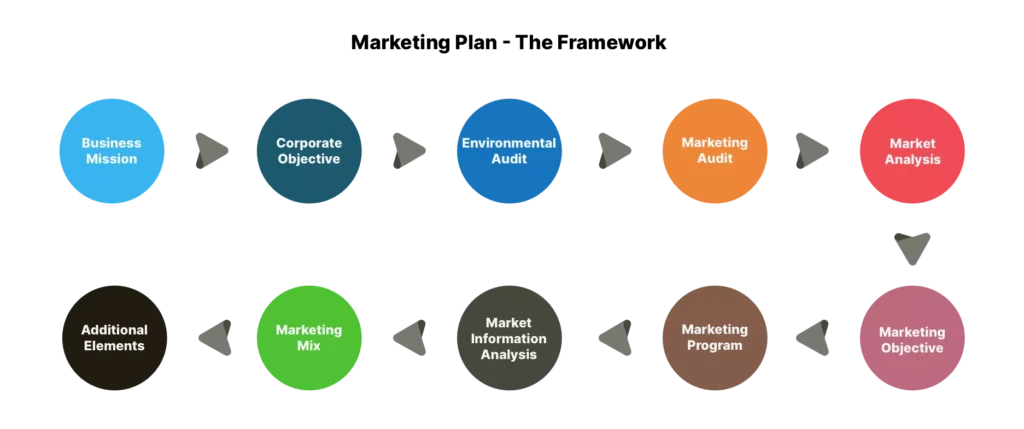Marketing does not just happen. Products and services need to be developed carefully to ensure that they reach the consumer in the right way at the right place, time, and price to lead to customer satisfaction and resulting profit for the supplier. This requires planning! The marketing plan is the result of all the planning that is required throughout the marketing process. But how to write a marketing plan? This article provides you with a clear framework for writing the perfect marketing plan.
The Need for a Marketing Plan
It may be very tempting for young companies or entrepreneurs to rush to market a new product or service. The planning stage is often partly or completely skipped. When things go wrong afterward, the cause is often the same: a lack of preparation and planning. The business idea will be very unlikely to be successfully implemented, which causes a loss of face, time, and money. This can be prevented with a good marketing plan: It is better to sit down and plan carefully before getting off to entering the market.
How to Write a Marketing Plan
All marketing planning comes together in the marketing plan. The marketing plan is a highly important framework that provides certainty in the potential of the product or service and a roadmap for implementation. When asking how to write a marketing plan, you often get differing answers. Hence, there is no absolutely fixed definition of what needs to be included and what is not. However, if you follow this framework for writing a perfect marketing plan, you will learn how to write a marketing plan – not any marketing plan, but a perfect one.
The Contents and Structure of the Marketing Plan
In essence, the marketing plan shows the direction that the marketing mix is expected to take. It gives estimates of crucial success factors such as customer demand in terms of market size and growth, competitor activity, opportunities, and threats in the market environment and how outlines the plan for responding to these factors with the right strategies.
We will now go through the elements of the marketing plan step by step. This will provide you with an overview of how to write a marketing plan in terms of content and structure.
Marketing Plan – The Framework

1. Business Mission
The business mission is a statement encompassing the whole operation, often following a general goal, for instance, to be the ‘market leader’ or ‘the most innovative supplier of goods and services’ within a selected industry.
2. Corporate Objective
The corporate objective covers the specifics of the business mission statement. Usually, objectives are given in quantifiable terms, for instance, to achieve a given turnover or market share or to increase on previous year’s performance. Qualitative objectives may be used as a supporting element, such as to raise product quality awareness among customers
3. Environmental Audit
The environmental audit aims to investigate the market environment in which the firm operates in terms of Political (including legal), Economic, Social, and Technological (PEST) issues. This can be extended to include the DEPEST factors, also called DESTEP or PESTLE factors.
4. Marketing Audit
The marketing audit is an analysis of competitor activity, providing the relative position of the company within the market. It involves undertaking a SWOT analysis covering the firm’s internal strengths and weaknesses as well as external opportunities and threats.
5. Market Analysis
The market analysis involves an assessment of market size, trends and segments; regional and local market characteristics; seasonal variations in sales, etc.
6. Marketing Objective and Major Strategies
In this part, the company needs to define objectives in terms of forecasts of increased sales, customer awareness, channel coverage for the product or service, and so on. Corporate strategies relate to the analyses of environmental and marketing audits discussed above and provide a roadmap for how to address these issues.
7. Marketing Programmes and Tactics
The marketing program addresses the implementation of marketing tactics to achieve the strategic objectives through the marketing mix, balancing product development, pricing, promotion, and channels of distribution (place) decisions.
8. Market Information Analysis
The market information analysis is supposed to lead to the discovery of market gaps, new markets/segments, customer characteristics, product life-cycle positioning and targeting, etc. It incorporates developing the Marketing Information System (MIS), marketing research methodology, and marketing research implementation. This may also include the selection of a marketing research agency, if appropriate.
9. Marketing Mix
The marketing mix should not be a new concept: It is the targeted combination of product, price, promotion, and channels of distribution (place) approaches. The four standard elements of the marketing mix include:
Product
Assessment of product characteristics, range, features; sales trends, performance history, and planned developments.
Pricing
Assessment of positioning strategy and customer-perceived values.
Promotion
Assessment of media advertising, direct mail, sales promotions, sponsorship, exhibitions, public relations, selling activity, and measurement of communication effectiveness.
Place
Assessment of channel strategy, channel selection, selling strategy, sales plan, and sales force organization.
10. Additional Elements
Resources
Constraints within which the plan has to operate.
Finance
Marketing budget, revenue, and gross margin forecast, target marketing ratios, and cash flow projection.
Time
Scheduling of proposed marketing activities within the plan (often portrayed using a Gantt chart).
Human resource management
Personnel requirements for implementing the plan, including appropriate recruitment and training.




